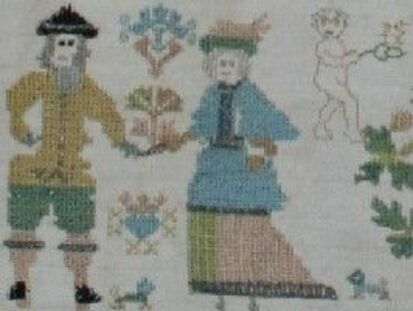ACG 1728


At first view, lovers holding hands and proud animals draw our attention. Afterwards one discovers Christian and secular "symbols of love" in nearly every pictorial section: penetrated, flaming and crowned hearts, the Lamb of God, the stork that brings the babies and quite a few carnations as symbol of the true and pure love.
A very harmonious sampler, worked in very strong colours once, with balanced parts of borders, alphabets and picture series.
Many of these motifs collected here were very popular at that time and therefore they appear again and again, stitched with great pleasure on samplers from Saxony.
Rather uncommon on German samplers are the so-called "boxer motif" and the small animal figure above the cat (The mouse tries to shoot "out of the sampler"!). The name derives from the figure's step forward and the position of the arms, usually holding a flower! Borders with boxers were very common in the 17th and 18th century. They have their origin in Italian and Spanish works of the 16th and. 17th century and make us think of Renaissance putti.
The needleworker decorated her motifs in different ways: stamens, tendrils and infants in swaddling clothes worked in back stitch or double running stitch, articles of clothing stepped in high contrast with mixed metal floss and four chain stitches depict the bonds between the two lovers. A very affectionate and diversified work.
This sampleris in the possession of the Museum für Sächsische Volkskunst in Dresden (Inventarnr. B44, Originalgröße 25 cm x 93 cm) Many thanks to the staff members of this Museum for their kind support.
Crosses: 179 x 677
Size: 26 x 97 cm
Stitches: Cross stitch, back stitch or double running stitch, herringbone stitch, chain stitch
